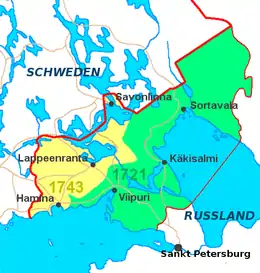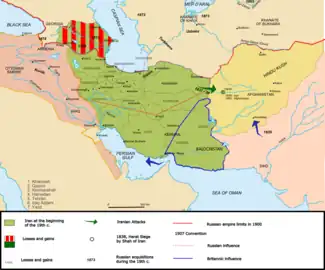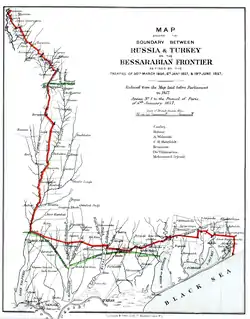Territorial evolution of Russia
The borders of Russia changed through military conquests and by ideological and political unions in the course of over five centuries (1533–present).

Russian Tsardom and Empire

The name Russia for the Grand Duchy of Moscow began to appear in the late 15th century, and became official in 1547 when the Tsardom of Russia was established. The Grand Duchy of Moscow was one of the successors in part of the territory of medieval Kievan Rus'. Another important starting point was the official end in 1480 of the overlordship of the Tatar Golden Horde over Moscovy, after its defeat in the Great Stand on the Ugra River. Ivan III (reigned 1462–1505) and Vasili III (reigned 1505–1533) had already expanded Muscovy's borders considerably by annexing the Novgorod Republic (1478), the Grand Duchy of Tver in 1485, the Pskov Republic in 1510, the Appanage of Volokolamsk in 1513, and the principalities of Ryazan in 1521 and Novhorod-Siverskyi in 1522.[1]
After a period of political instability between 1598 and 1613, which became known as the Time of Troubles, the Romanovs came to power (1613) and the expansion-colonization process of the Tsardom continued. While western Europe colonized the New World, the Tsardom of Russia expanded overland – principally to the east, north and south.
This continued for centuries; by the end of the 19th century, the Russian Empire reached from the Baltic Sea, to the Black Sea, to the Pacific Ocean, and for some time included colonies in the Americas (1732–1867) and a short-lived unofficial colony in Africa (1889) in present-day Djibouti.[2]
Expansion into Asia

The first stage from 1582 to 1650 resulted in North-East expansion from the Urals to the Pacific. Geographical expeditions mapped much of Siberia. The second stage from 1785 to 1830 looked South to the areas between the Black Sea and the Caspian Sea. The key areas were Armenia and Georgia, with some better penetration of the Ottoman Empire, and Persia. By 1829, Russia controlled all of the Caucasus as shown in the Treaty of Adrianople of 1829. The third era, 1850 to 1860, was a brief interlude jumping to the East Coast, annexing the region from the Amur River to Manchuria. The fourth era, 1865 to 1885 incorporated Turkestan, and the northern approaches to India, sparking British fears of a threat to India in the Great Game.[3][4]
Historian Michael Khodarkovsky describes Tsarist Russia as a "hybrid empire" that combined elements of continental and colonial empires.[5] According to Kazakh scholar Kereihan Amanzholov, Russian colonialism had "no essential difference with the colonialist policies of Britain, France, and other European powers".[6] Qing China defeated Russia in the early Sino-Russian border conflicts, although the Russian Empire later acquired Russian Manchuria in the Amur Annexation.[7] During the Boxer Rebellion, the Russian Empire invaded Manchuria in 1900, and the Blagoveshchensk massacre occurred against Chinese residents on the Russian side of the border.[7] Russian Empire reached its maximum territory in Asia with the Russo-Japanese War, where after its defeat, Russia ceded Manchuria, southern Sakhalin, Russian Dalian, and Port Arthur to Japan with the Treaty of Portsmouth, though Russia kept the northern portion of the Chinese Eastern Railway.
Table of changes
Czarist and imperial Russia's territorial gains and losses, up to the 1905 Russian Revolution, listed chronologically:
The Russian SFSR and the Soviet Union
After the October Revolution of November 1917, Poland and Finland became independent from Russia and remained so thereafter. The Russian empire ceased to exist, and the Russian SFSR, 1917–1991, was established on much of its territory. Its area of effective direct control varied greatly during the Russian Civil War of 1917 to 1922. Eventually the revolutionary Bolshevik government regained control of most of the former Eurasian lands of the Russian Empire, and in 1922 joined the RSFSR to Belarus, Transcaucasia, and Ukraine as the four constituent republics of a new state, the Union of Soviet Socialist Republics (or Soviet Union, USSR), which lasted until December 1991.

Territories of the former Russian Empire that permanently or temporarily became independent:
- Crimean People's Republic, 1917–1918
- Republic of Aras, 1918–1919
- Alash Autonomy, 1917–1920
- Kingdom of Lithuania (1918), 1918
- Ukrainian People's Republic, Ukrainian State, 1917–1921
- Duchy of Courland and Semigallia (1918), 1918
- First Republic of Armenia, 1918–1920
- Azerbaijan Democratic Republic, 1918–1920
- Republic of Finland, 1917–
- Kingdom of Finland (1918), 1918–1919
- Belarusian Democratic Republic, 1918–1919
- Balagad state, 1919–1926
- North Caucasian Emirate, 1919–1920
- Republic of Latvia, 1919–1940
- Republic of Central Lithuania, 1920–1922
- Centrocaspian Dictatorship, 1918
- Democratic Republic of Georgia, 1918–1921
- Moldavian Democratic Republic, 1917–1918
- Mountainous Republic of the Northern Caucasus, 1917–1920
- North Ingria, 1919–1920
- Transcaucasian Democratic Federative Republic, 1918
In 1919, northern Mhlyn, Novozybkiv, Starodub, and Surazh counties (povits) of Ukraine's Chernihiv Governorate were transferred from the Ukrainian SSR to the new Gomel Governorate of the Russian republic.[8] In February 1924, Tahanrih and Shakhtinsky counties (okruhas) were transferred from the Donetsk Governorate of Ukraine to Russia's North Caucasus krai.[9][10]
By the end of World War II the Soviet Union had annexed:

- Western Belarus and Western Ukraine from the Second Polish Republic (see Territories of Poland annexed by the Soviet Union), annexed in September–October 1939
- Estonia, Latvia, and Lithuania, occupied in August 1940
- Bessarabia (Moldova), Hertsa, and part of Bukovina, occupied from Romania after an ultimatum in 1940
- Parts of Karelia and Salla in 1940, Pechengsky Raion (Petsamo) in 1944, and a 50-year lease on the naval base at Porkkala in 1944
- Carpathian Ruthenia, formerly in Czechoslovakia and occupied in 1944
- Tuva (independent 1921–1944; previously governed by Mongolia and by the Manchu Empire)
- East Prussia (now Kaliningrad Oblast) from Germany, in 1945
- The Klaipėda Region, annexed to Lithuania in 1945
- The Kuril Islands and southern Sakhalin from Japan, occupied in 1945
Of these, Pechenga, Salla, Tuva, Kaliningrad Oblast, Klaipėda, the Kurils, and Sakhalin were added to the territory of the RSFSR.
The Chinese Eastern Railway, formerly a tsarist concession, was taken again by the Soviet Union after the 1929 Sino-Soviet conflict,[11] the railway was returned in 1952.[12]
Meanwhile, territories were removed from the Russian SFSR, including Turkmenistan and Uzbekistan in 1924, Kazakhstan and Kyrgyzstan in 1936, and Karelo-Finland from 1945 to 1956. The Crimean oblast and city of Sevastopol were transferred to Ukraine on 19 February 1954 (later annexed by the Russian Federation in 2014).
There were numerous minor border changes between Soviet republics as well.
After World War II, the Soviet Union set up seven satellite states, known as “European colonies”, while remaining independent though their politics, military, foreign and domestic policies were dominated by the Soviet Union:[13]
Russian Federation

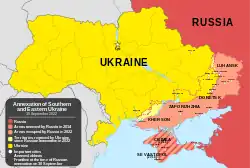
The dissolution of the Soviet Union has led to the creation of independent post-Soviet states, with the Russian SFSR declaring its independence in December 1991 and changing its name to the Russian Federation.
The Chechen Republic of Ichkeria was a secessionist government of the Chechen Republic during 1991–2000. After Russian defeat at the Battle of Grozny, the First Chechen War ended with Russia recognizing the new Ichkerian government of president Maskhadov in January 1997 and signing a peace treaty in May. But Russia invaded again in 1999, restoring a Chechen Republic and the Ichkeria government was exiled in 2000.
The Russian Federation has been involved in territorial disputes with several its neighbours, including with Japan over the Kuril Islands, with Latvia over the Pytalovsky Raion (settled in 1997), with China over parts of Tarabarov Island and Bolshoy Ussuriysky Island (settled in 2001), with its coastal neighbours over Caspian Sea boundaries, and with Estonia over the adjoining border. Russia also had disputes with Ukraine over the status of the federal city of Sevastopol, but agreed it belonged to Ukraine in the 1997 Russian–Ukrainian Friendship Treaty, and over the uninhabited Tuzla Island, but gave up this claim in the 2003 Treaty on the Sea of Azov and the Kerch Strait.
The Russian Federation has also used its armed forces, armed formations, and material support to help establish the disputed breakaway states of Transnistria in Moldova after the Transnistria War, and South Ossetia and Abkhazia, after the 2008 war in Georgia. In 2008, shortly after announcing the recognition of Abkhazia and South Ossetia, Russian president Dmitry Medvedev laid out a foreign policy challenging the US-dominated "single-pole" world order and claiming a privileged sphere of influence in the near abroad around the Russian Federation and farther abroad.[14][15] Following these conflicts, both Transnistria and South Ossetia have made proposals for joining Russia.
In 2014, when after months of protests in Ukraine, pro-Russian Ukrainian president Viktor Yanukovych was deposed in the Revolution of Dignity, Russian troops occupied Ukraine's Crimean peninsula, and after a hasty referendum the Kremlin annexed Crimea and Sevastopol. The annexation was not recognized by Ukraine or most other members of the international community. A few weeks later, an armed conflict broke out the Donbas region of Ukraine, in which the Kremlin denies an active role, but is widely considered to be fuelled by soldiers, militants, weapons, and ammunition from the Russian Federation.
On February 21, 2022, the Russian president Putin signed a decree recognizing the independence of two Donbas republics in Ukraine, and invaded the region. Two days later, Russian troops openly invaded Ukrainian-held territory of Ukraine, a move widely seen as an attempt to conduct regime change and occupy much or all of Ukraine. After failing to seize Ukraine's capital Kyiv for over a month, the Russian defence minister stated that the main goal of the war was the "liberation of the Donbas",[16] but later a Russian general stated that it was to seize eastern and southern Ukraine right through to Transnistria, a breakaway territory in Moldova.[17][18]
On 30 September 2022, Putin announced in a speech[19] that Russia was to annex four partially occupied regions of Ukraine: Donetsk, Kherson, Luhansk, and Zaporizhzhia Oblasts.[20] However, Russia's annexation of these territories was widely condemned by the international community,[21] and Russia does not control the full territory of any of the four annexed regions, and its government was unable to describe the new international "borders".[22]
See also
- Chechen–Russian conflict
- Foreign policy of the Russian Empire
- Foundations of Geopolitics
- History of the administrative division of Russia
- Internal colonialism
- Kaliningrad question
- Karelian question
- Moscow, third Rome
- Post-Soviet conflicts
- Russian imperialism
- Russian irredentism
- Russification
- Derussification
- Soviet Empire
- Timeline of geopolitical changes
- List of national border changes from 1815 to 1914
- List of national border changes (1914–present)
References
- Allen F. Chew, An Atlas of Russian History: Eleven Centuries of Changing Borders (2nd ed. 1967). pp 14–43.
- John Channon, The Penguin historical atlas of Russia (1995) pp 8–12, 44–75.
- Brian Catchpole, A map history of Russia (1983) pp 6–31.
- Allen F. Chew, An Atlas of Russian History: Eleven Centuries of Changing Borders (2nd ed. 1967)
- "Empire of the steppe: Russia's colonial experience on the Eurasian frontier". www.international.ucla.edu. Retrieved 9 August 2021.
- "The Great Game, 1856-1907: Russo-British Relations in Central and East Asia | Reviews in History". reviews.history.ac.uk. Retrieved 9 August 2021.
- Lin, Yuexin Rachel (2017). "White water, Red tide: Sino-Russian conflict on the Amur 1917–20". Historical Research. 90 (247): 76–100. doi:10.1111/1468-2281.12166. hdl:10871/31582. ISSN 1468-2281.
- "Chernihiv gubernia". Encyclopedia of Ukraine. Retrieved 28 May 2020.
- Struk, Danylo Husar (15 December 1993). Encyclopedia of Ukraine: Volume IV: Ph-Sr. University of Toronto Press. ISBN 9781442651265.
- Krinko, Evgeny F. (2015). "'…To Elect a Parity Commission': Documents about the Transfer of Taganrog and Shakhty Districts to the RSFSR in 1924–1925" (PDF). Russkii Arhkiv. 10 (4): 288–295. doi:10.13187/ra.2015.10.288.
- Walker, Michael M. (2017). The 1929 Sino-Soviet war : the war nobody knew. Lawrence, Kansas. ISBN 978-0-7006-2375-4. OCLC 966274204.
{{cite book}}: CS1 maint: location missing publisher (link) - Elleman, Bruce A. (1994). "The Soviet Union's Secret Diplomacy Concerning the Chinese Eastern Railway, 1924–1925". The Journal of Asian Studies. 53 (2): 459–486. doi:10.2307/2059842. ISSN 0021-9118. JSTOR 2059842. S2CID 162586404.
- Vladimir Tismaneanu, Marius Stan, Cambridge University Press, 17 May, 2018, Romania Confronts Its Communist Past: Democracy, Memory, and Moral Justice, p. 132
- Kramer, Andrew E. (1 September 2008). "Russia Claims Its Sphere of Influence in the World". The New York Times. ISSN 0362-4331. Retrieved 30 November 2020.
- "Interview given by Dmitry Medvedev to Television Channels Channel One, Rossia, NTV". President of Russia. Archived from the original on 17 December 2020. Retrieved 30 November 2020.
- "Russia pledges to scale down military activity near Kyiv, Chernihiv — live updates". DW.COM. 29 March 2022. Retrieved 29 March 2022.
- Ma, Alexandra. "Russia says its goal in Ukraine is to conquer the country's eastern and southern regions". Business Insider. Retrieved 24 April 2022.
- "Ukraine war: What are Russia's plans for its 'second phase' - and why does it include Moldova?". ca.news.yahoo.com. 22 April 2022. Retrieved 24 April 2022.
- "Signing of treaties on accession of Donetsk and Lugansk people's republics and Zaporozhye and Kherson regions to Russia". Kremlin.
- Reuters Staff (30 September 2022). "Putin says Russia has 'four new regions' as he announces annexation of Ukrainian territory". Reuters. Archived from the original on 30 September 2022. Retrieved 30 September 2022.
{{cite news}}:|author=has generic name (help) - "Global condemnation for Russia's illegal annexation of Ukrainian territory". DW.
- "Russia no longer has full control of any of four 'annexed' Ukrainian provinces". Guardian.
Further reading
- Bassin, Mark. "Russia between Europe and Asia: the ideological construction of geographical space." Slavic review 50.1 (1991): 1–17. Online
- Bassin, Mark. "Expansion and colonialism on the eastern frontier: views of Siberia and the Far East in pre-Petrine Russia." Journal of Historical Geography 14.1 (1988): 3–21.
- Forsyth, James. "A History of the Peoples of Siberia: Russia's North Asian Colony 1581–1990" (1994)
- Foust, Clifford M. "Russian expansion to the east through the eighteenth century." Journal of Economic History 21.4 (1961): 469–482. Online
- LeDonne, John P. The Russian empire and the world, 1700–1917: The geopolitics of expansion and containment (Oxford University Press, 1997).
- McNeill, William H. Europe's Steppe Frontier: 1500–1800 (Chicago, 1975).
- Subtelny, Orest (1988). Ukraine: A History. Toronto: University of Toronto Press. ISBN 978-0-8020-5808-9.
- Plamen Mitev, ed. Empires and peninsulas: Southeastern Europe between Karlowitz and the Peace of Adrianople, 1699-1829 (LIT Verlag Münster, 2010).
- Treadgold, Donald W. "Russian expansion in the light of Turner's study of the American frontier." Agricultural History 26.4 (1952): 147–152. Online
- Velychenko, Stephen, The Issue of Russian Colonialism in Ukrainian Thought.Dependency Identity and Development, AB IMPERIO 1 (2002) 323-66
Atlases
- Blinnikov, Mikhail S. A geography of Russia and its neighbors (Guilford Press, 2011) Borrow at Internet Archive
- Catchpole, Brian. A map history of Russia (1983)
- Chew, Allen F. An Atlas of Russian History: Eleven Centuries of Changing Borders (2nd ed. 1967) Borrow at Internet Archive
- Gilbert, Martin. Routledge Atlas of Russian History (4th ed. 2007) 8th ed. 2010 at Internet Archive
- Parker, William Henry. An historical geography of Russia (University of London Press, 1968) Borrow at Internet Archive
- Shaw, Denis J.B. Russia in the modern world: A new geography (Blackwell, 1998) Borrow at Internet Archive



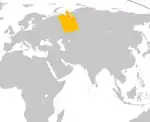
.svg.png.webp)

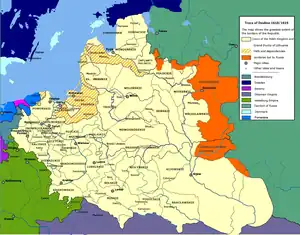


.svg.png.webp)


